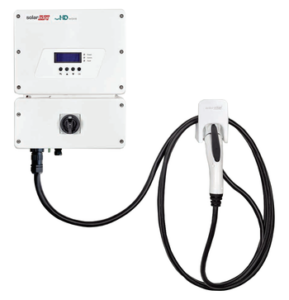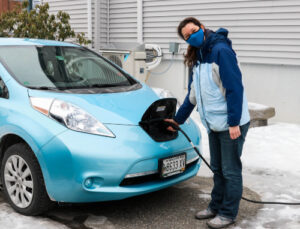
Electric Vehicle Charger Installations
 Many Mainers want to reduce their reliance on foreign oil and find clean transportation solutions. Electric vehicles (EVs) are a great way to realize these goals!
Many Mainers want to reduce their reliance on foreign oil and find clean transportation solutions. Electric vehicles (EVs) are a great way to realize these goals!
Sundog Solar installs EV charging stations on homes and businesses, allowing for rapid and convenient vehicle charging. Combined with a solar PV system, your electric vehicle can run off of 100% renewable energy!
EV Charging for Your Home or Business
Sundog Solar installs commonly installs two different electric vehicle charging stations for homes and businesses.
ClipperCreek Chargers
The American-made, ClipperCreek electric vehicle charging stations for plug-in hybrid and battery electric vehicles is an excellent option. Level 2 EV chargers recharge most cars in just a few hours. This high-powered Level 2 EVSE is compatible with all major models of  electric vehicles, including the Chevy Bolt, Nissan Leaf, and BMW i3. It has a 25-foot cable for added convenience.
electric vehicles, including the Chevy Bolt, Nissan Leaf, and BMW i3. It has a 25-foot cable for added convenience.
SolarEdge EV Charger & Solar Inverter
Sundog Solar also installs an innovative solar inverter with an integrated electric vehicle charger. This product by SolarEdge allows electric vehicles to charge six times faster than a standard Level 1 charger. Combining the solar inverter and EV charger reduces installation costs by eliminating the need for a dedicated breaker, thus reducing wiring and reducing labor.
This 2-in-1 solution from SolarEdge allows you to track your solar electricity production and electric vehicle power consumption from a mobile app. It even has remote capabilities, allowing you to turn charging capabilities on and off. Even if you want to go solar now and have electric vehicle charging capabilities for the future, this combo unit is a great option!
Quality EV Charger Installations by Sundog Solar
Our team is skilled in installing high-quality electric vehicle charging stations throughout Maine. Sundog Solar has licensed electricians that are skilled in installing Level 2 EV charging stations. We typically install the chargers in garages, driveways, office buildings, or wherever they are most convenient.
Advantages of Electric Vehicles in Maine
- Lower your carbon emissions
- Save money on fuel
- Energy independence
From Rockland to Camden, Augusta, Brewer, Orono, Waldoboro, Castine, and beyond, electric vehicles allow drivers to save money on fuel. Our company vehicle, a Chevy Bolt has a range of 238 miles and costs less than $10 per charge.
Two-thirds of Maine’s electricity comes from renewable sources, primarily hydroelectric dams, biomass generators, wind turbines, and solar panels, according to the U.S. Energy Information Administration. Therefore, using an electric vehicle reduces greenhouse gas emissions even if you don’t have a solar system. Be part of the clean transportation movement in Maine!
If you install a solar PV system, your EV charging station can power your electric car with energy from the sun. This means that your car isn’t using any fossil fuels!
How many solar panels does it take to charge an EV?
Solar energy and electric vehicles (EVs) are an excellent combination. Charging your car with your own solar panels allows you to both power your home and your vehicle with renewable energy. This is an excellent way to reduce fossil fuel use and lower your energy expenses. However, it is important to size your solar energy system properly to get the most value out of it. The Sundog Solar team is skilled in sizing solar systems for optimum cost savings and energy output.
The average family needs roughly 5 to 12 solar panels to charge their vehicle throughout the year. But, the exact amount of solar panels you will need to have to charge your car will vary on a few factors.
Consider:
- How far do you drive annually?
- How efficient is your electric vehicle?
- Do you always charge at home, or do you sometimes charge when you are out and about or at work?

Although the efficiency of electric cars varies, the average car needs about 30 kWh to drive 100 miles. The average EV owner drives about 5,300 miles per year. Let’s assume that you only charge at home. That would mean that you consume about 1,600 kWh annually to charge your car. That’s about 5 solar panels in Maine.
If you drive 10,000 miles annually and only charge at home, you would need about 10 solar panels to charge your car each year. Likewise, if you do about half your charging on the go, five solar panels for charging your car at home might be sufficient.
Sundog Solar design specialists can review your power bills to determine your total household energy consumption. This is the most accurate way to size a solar system unless you expect your household electricity use to change significantly.

